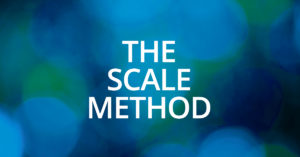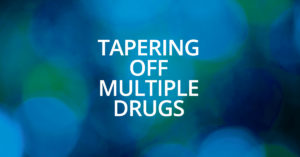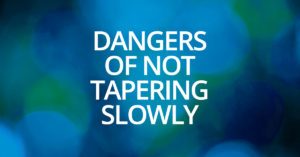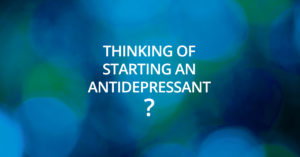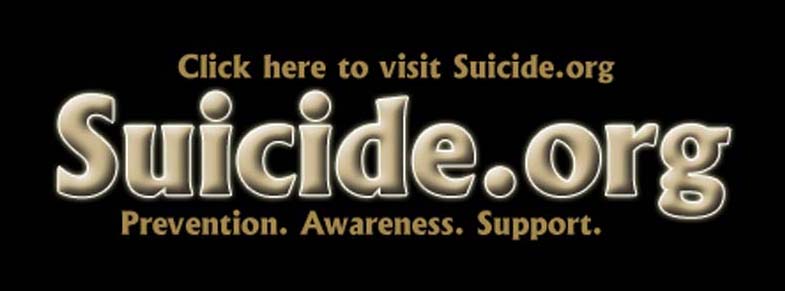DISCLAIMER: THIS IS NOT MEDICAL ADVICE! We do not employ doctors or licensed medical professionals, so we do not provide medical advice. Nothing presented here is a substitute for the advice of a DOCTOR or other licensed health care provider. Never stop, start or add medications or supplements to your health or mental health care regime without first checking for interactions or other problems, and thoroughly researching the substance. Before you employ any information here, consult your health care professional. No information here is the result of valid clinical trials.
Tapering Off Multiple Drugs
There are three schools of thought on tapering multiple drugs:
- Taper one drug at a time in order to see how decreases affect withdrawal symptoms.
- Taper all at once - very slowly - your brain and body are already used to the combination of drugs. So this will cause the least amount of disruption to your brain. The problem with this method is that if one of the drugs is causing a problem, you won't know which one. Trying to figure out the different doses of all the drugs could be a challenge, too. (Antidepressant expert Ann Blake-Tracy recommends this method.)
- The stair-step method: one drug is slow-tapered for a while, and then tapering that drug is stopped. Then tapering the next drug begins. By alternately tapering each drug, all drugs are slowly and deliberately discontinued.
We recommend you taper the most activating drug first
- Normally, Cymbalta is the most activating, so you should taper that fully. Then you taper off the ones that are more sedating.
From Surviving Antidepressants: http://survivingantidepressants.org/topic/2207-taking-multiple-psych-drugs-which-drug-to-taper-first/ - "If no one drug is clearly causing an adverse effect, discontinue the more activating drugs first."
- Antidepressants and ADHD drugs (mostly amphetamine analogs) tend to be activating drugs. These cause jitteriness, anxiety, or sleeplessness.
- Benzodiazepines, the "Z" drugs for sleep, anticonvulsants (such as Lamotrigine), Lyrica, Gabapentin (Neurontin), and antipsychotics tend to be regulating or sedating drugs. These cause drowsiness, sluggishness or dopiness.
- The two types of drugs can be thought of as "accelerators" and "brakes."
Many people have a sedating drug -(a brake) added to an activating drug (an accelerator) to treat drug-induced anxiety or sleep problems.
- In this case we suggest you taper the antidepressant or stimulant first, unless you are having clear adverse reactions to a particular drug. Otherwise, you will experience activation from the other drug as you decrease the "brake." The brake may make it easier to manage withdrawal symptoms.
- The most common and significant antidepressant withdrawal symptoms are: nervous system activations (indicating a too-fast taper); hyper-alertness; sleeplessness; abnormal anxiety; agitation etc.
- Withdrawal sleeplessness makes tapering much harder and recovery from post-withdrawal syndrome more difficult.
- If you reduce the accelerator while taking a sedating drug, the sedating drug may help you manage the withdrawal better. You may plan to taper the sedating drug later.
BUT ... Don't add a "brake" to prepare for withdrawal
- Do not increase your risk of neurological damage by increasing the number of different drugs you take. A new drug may interact with one you are already taking.
- The sedating drugs will also need tapering and can create a withdrawal syndrome of their own.
- Remember to check drug interaction at www.drugs.com/drug_interactions.html
CHW Fighting Insomnia
Fighting insomnia with a better sleep environment and routine
Two powerful weapons in the fight against insomnia are a quiet, comfortable bedroom and a relaxing bedtime routine. Both can make a big difference in improving the quality of your sleep.
CHW The Scale Method
When you post, help us to support you. We need the full picture. For us to help you properly when you post, we need that information. So it is very important to keep a journal while tapering.
Read MoreCHW Tapering Off Multiple Drugs
There are three schools of thought on tapering multiple drugs: 1) Taper one drug at a time in order to connect decreases to withdrawal symptoms.2) Taper all at once – very slowly 3) The stair-step method, where one drug is slow tapered for awhile, and then tapering that drug is stopped before tapering the next drug begins.
Read MoreCHW Dangers of Not Tapering Slowly
DISCLAIMER: THIS IS NOT MEDICAL ADVICE! We do not employ doctors or licensed medical professionals, so we do not provide medical advice. Nothing presented here is a substitute for the advice of a DOCTOR or other licensed health care provider.…
Read MoreCHW Thinking of Starting an Antidepressant?
Informed consent and questions for your doctor. For example: When doctors say this… ask this.
Read MoreCHW Reinstatement Guidelines
There is only a 2 (possibly 3) week reinstatement window where it is (somewhat) safe to go back onto the drug to try to reverse the withdrawal, but only if other drugs have not been added and the person did not alternate days more than 2 (possibly 3) weeks. After that window passes, the person is left to deal with whatever comes their way. There is no known “cure” for protracted withdrawal once it settles in. It just takes time to resolve on its own.
Read MoreLooking for help with something?
Search our site below...
Please take the time to report your adverse symptoms from Cymbalta and Cymbalta withdrawal to the FDA. Call 1-800-332-1088 ![]()
© 2019 Healing America Now


